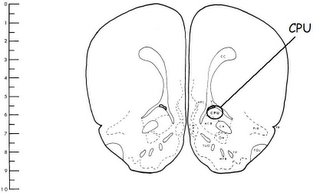Some time ago, I promised a post on what I learned about the chemical aspects of zombification, as told to me by a chemist, no less. Since then, I haven't gotten around to writing it up, partly because I spend 3 hours a day every day commuting (not that I'm
bitter or anything, mind you), and partly because I have access to the computer only when LL isn't using it for work.
But another big part of why I've procrastinated has to do with the controversy behind the explanation. It turns out zombification isn't nearly as cut-and-dried a mechanical process as I had originally believed. There is a lot of disagreement among scientists about whether and how it exists. Additionally, there are charges of racism against one of the most prominent investigators of the phenomenon, and I certainly don't want to be a part of spreading racist falsehoods out of ignorance (don't forget,
Blog Against Racism Day is coming right up--Dec. 1!).
So as much as I hate "he said, she said" American journamalism, and think it's intimately tied up with a lot of the political problems we now have, I'm going to report on what I was able to find out, but I can't give the definitive word on which position is [closer to] the truth. In other words, in true creationist style, I'm going to "teach the controversy" on zombification. And while that, as we shall see later, does not have to be harmful, it can also fall way short of the mark as well.
First of all, with all due respect to
Jon Singer (and that's a lot of respect!), we are going to have to agree to disagree about
cassava. In my opinion--and I am speaking only for myself, mind you--anything which is responsible for degenerative ataxic neuropathy unless you prepare it "properly" is NOT a food in my book. The fact that there is a scientific controversy over whether the neural degeneration is caused by the cassava's cyanide, or by
another neurotoxin also present is merely a sideshow (Mathangi DC, Namasivayam A. Neurochemical and behavioural correlates in cassava-induced neurotoxicity in rats. Neurotoxicity Research, 2000;2(1):29-35.).
I realize that subsistence farmers in sub-Saharan Africa are not in a position to have the same choices as I do, and cassava is an important part of their diet. In writing of the neurotoxocity of cassava, I certainly do not mean any disrespect to their history, traditions, and cultures. Nevertheless, there is a fairly large literature in PubMed about what can happen in the short- and long-term to individuals and populations when the cassava is not properly processed. I think that health care is a human right, and that that also means universal access to healthy foods that do not put you at the risk of neurodegenerative diseases. Still, I have to acknowledge that, given (white) Western attempts to stamp out other cultures, it is a very thorny question when you address traditional practices that may be harmful.
A similar issue is encountered among the Chamorro people of Guam--there is a disease found only there, lytico-bodig, which seems to be related in varying degrees to Parkinson's disease, Lou Gehrig's disease (amyotrophic lateral sclerosis, or ALS), and Alzheimers. Oliver Sacks wrote about it in
The Island of the Colorblind, which I found a fascinating description which made me want to learn more and eventually be able to do something to help. However, Alexander Cockburn equates him with a supermarket tabloid writer. (I have yet to see Cockburn approve of anyone or anything, so what
ever, Cockburn.)
One hypothesis of the origin of lytico-bodig (and I'm really skimming here, to get to the zombies) is that the ferny-looking-but-by-no-means-related
cycads (hello, convergent evolution!) eaten on Guam have chemicals that cause the neurodegeneration. Further, there is now an article that links bat-eating to lytico-bodig--the idea is that the neurotoxin is consumed by cycad-eating bats and stored in their tissues, causing a biomagnifier effect when humans eat the bats. (Ince PG, Codd GA. Return of the cycad hypothesis - does the amyotrophic lateral sclerosis/parkinsonism dementia complex (ALS/PDC) of Guam have new implications for global health? Neuropathology and Applied Neurobiology. 2005 Aug;31(4):345-53.)
Again, I'm very pro-bat, and pro-non-neurodegenerative-diet, but at the same time, I can't help but be aware of the issues of addressing medical consequences of traditional practices, especially with peoples whose options are limited.
The same issues of trans-cultural medical judgment apply when looking at the practice of eating
fugu, or pufferfish, although typically the people who eat this species cannot be said to be lacking in options--fugu can be quite an expensive delicacy. But again, like cassava, it has to be properly prepared, or it will kill you--and properly prepared in this case means complete removal of the liver and ovaries in such a way that the tetrodotoxin does not remain in the tissues in sufficient amounts to kill you (although a slight tingling in the lips and tongue from the neurotoxin is said to be a delightful part of the gourmet fugu experience).
I've seen fugu at the
Seattle Aquarium, and, like cassava, their toxicity puts them right out of the "food" category for me, although I do have to admit they are beautiful to look at. They are also the link from the previous discussion to the topic of zombification.
Wade Davis, an anthropologist and ethnobotanist, hypothesized that the Caribbean pufferfish are one of the active ingredients in zombie powder. According to his book
The Serpent and the Rainbow, the vodou practitioner would mix up a powder containing (among other ingredients) tetrodotoxin from the cooked puffer fish. According to the chemist who related this hypothesis to me, it is like giving the victim a "chemical lobotomy"--the tetrodotoxin blocks the sodium ion channels of the axon, interfering with the action impulse to the muscles. But it doesn't cross the blood-brain barrier, so the victim remains conscious but paralyzed, aware of what is happening, but unable to do anything about it.
Allegedly, people have been buried alive in this state, although I can't verify that personally. What I can verify is that when I had four teeth pulled for braces, the dentist gave me general anesthetic, but started just a moment too soon with the tooth extraction. It was right before I went totally under, and so I couldn't move or cry out, but could only lie there as I felt the tooth ripped out of my jaw. Fortunately, either the anesthetic kicked in, or I passed out at that point--either way, the remaining three teeth were extracted while I was under. So I've got to say that the idea of zombies being aware of what is going on, yet unable to react, really freaks me out.
So, supposedly, the tetrodotoxin causes paralysis and decreases respiration and other bodily activity, to the point where the victim is supposedly pronounced dead and buried. Later, when the toxin wears off, the practitioner is supposed to disinter him, and use him as a slave--while the paralysis wears off, the neurodegenerative effets don't, and the victim remains impaired--thus the term "chemical lobotomy".
It is a simple and understandable scenario, but the more digging I did, the more questionable it became. Davis is accused in some circles of scientific fraud, and in others of racism in the way he wrote about Haitians. Scientists (among others, toxicologists) don't agree on whether zombies exist, or, if they do, whether the effects of tetrodotoxin are sufficient to account for them. Replication of the effects has been problematic, and people have distanced themselves from the controversy. Additionally, some researchers claim that the so-called zombies are mentally ill, not poisoned. Under this scenario, all the attention given to the tetrodotoxin hypothesis detracts from the real problems of schizophrenia, fetal alcohol syndrome, and other disorders.
So the answer is: I just don't know.
And because I can't say for sure, I am going to have to leave it at that unsatisfying point of reporting the controversy, but not being able to resolve it, or even to predict which way it will ultimately be resolved. It is an interesting idea: tetrodotoxin as chemical lobotomy via blocking the axon's sodium ion channels--but ultimately unresolvable at present.
Read more!





